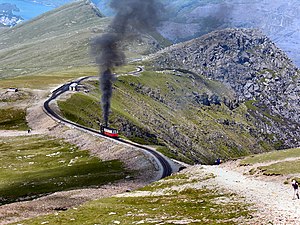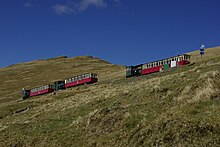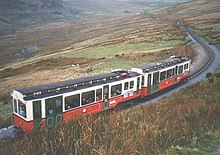Snowdon Mountain Railway
| Snowdon Mountain Railway | |
|---|---|
|
A steam train leaves the Clogwyn crossing station.
| |
| Route length: | 7.6 km |
| Gauge : | 800 mm ( narrow gauge ) |
| Maximum slope : | 167 ‰ |
| Rack system : | Dept |
The Snowdon Mountain Railway (Welsh Rheilffordd yr Wyddfa ) is the only rack railway in Great Britain . Your starting point is Llanberis in North Wales . The track has a track width of 800 mm. The racks used correspond to the Dept. system .
history
As early as 1869, the first suggestions were made to build a railway line on Snowdon , the highest mountain in Wales, after Llanberis had been connected to the British railway network. The owner of the land, however, did not allow this, as he feared that the railway would destroy the landscape. A few years later, however, a plan to build a railway from Rhyd Ddu to Snowdon called the residents of Llanberis on the plan, who feared a decline in tourism income. Therefore, the Snowdon Mountain Tramway and Hotel Company was founded to build the current railway, with the say of the landowner reduced to a minimum.
Construction of the line began in December 1894 and after just over a year the first train reached the mountain station in January 1896. After some minor remaining work, the railway was opened at Easter 1896. However, on the opening day, April 4, 1896, the first serious accident occurred when a locomotive derailed and fell a little way down the mountain slope. The locomotive crew saved themselves by jumping out of the locomotive; there was only one fatality among the passengers: although the wagons were stopped by the automatic brakes on the route, one passenger did the same as the locomotive crew and suffered serious head injuries when he fell whom he later died. Due to unexplained circumstances, a second train also drove to the scene of the accident, but did not cause any major damage. After some modifications, which included additional safety precautions, the line was reopened on April 9, 1897 and has remained in operation since then, with the exception of World War II. In 1962 the Caernarfon-Llanberis railway line, which had originally encouraged the construction of the Snowdon Mountain Railway, was discontinued. In the meantime, a new tourist attraction had developed in Llanberis with the Llanberis Lake Railway .
route
Over a length of approx. 7.5 km it overcomes an altitude difference of approx. 1000 m from the valley station in Llanberis (108 m) to just below the summit of Snowdon (1085 m), the highest mountain in Wales. The line is single-track and has a total of six stations. Apart from the terminus stations, there are sidings at three of the four stations on the route, which are arranged in such a way that a train travels 15 minutes between them. Therefore, maximum in a 30 minute clock , two trains will run, but being at a higher volume of traffic "at sight", so in a relatively short distance can drive a row.
The administration and depot of the railway are also located at the Llanberis valley station . After a short, relatively flat section of the route, the steep slope of 16.7% (1: 6) begins, which is why the railway was built as a rack railway. The two following stations , Hebron station at an altitude of 326 m and halfway station at 500 m , are no longer manned by train personnel, and you are not allowed to get on or off there. The fourth station, Rocky Valley Halt , is used as the terminus when the trains cannot run to the mountain station due to adverse weather conditions, so there is also a platform here, but no bypass as at the other stations.
This is followed by a longer section in which the railway continues to climb on a relatively narrow ridge until the next station, Clogwyn Halt (779 m), is reached. Getting off is not allowed here either. If there are still free places, you can get on trains going downhill. Finally the mountain station ( Summit Station , 1065 m) is reached. From there, a footpath leads to the 20 m higher summit of Snowdon.
vehicles
The railway was opened in 1896, until today there are individual steam locomotives built by SLM with matching wagons from the opening year in use. The main load of the traffic today is carried by four diesel locomotives (numbers 9–12) from the years 1986–1992 with four 74-seat wagons (numbers 14–17) from 2013. Three diesel railcars from 1995 were allowed because they only have one gear wheel each. only operate as a two or three-part unit. However, due to their lower reliability, the railcars have not been used since 2001 (railcars 21) or 2003 (railcars 22 and 23) and were scrapped in 2010.
A train usually consists of a locomotive and an introductory car, which basically runs uphill. In addition, a works train travels the entire route every morning , which is not only used for work, but also ensures the supply of the mountain station.
| No. | Surname | Construction year | design type | Remarks |
|---|---|---|---|---|
| 1 | LADAS | 1895 SLM 923 | Steam locomotive | Destroyed in an accident on the opening day |
| 2 | Enid | 1895 SLM 924 | Steam locomotive | in operation |
| 3 | Wyddfa | 1895 SLM 925 | Steam locomotive | in operation |
| 4th | Snowdon | 1896 SLM 988 | Steam locomotive | Revision planned |
| 5 | Moel Siabod | 1896 SLM 989 | Steam locomotive | stored away from home |
| 6th | Padarn | 1922 SLM 2838 | Steam locomotive | Revision planned |
| 7th | Ralph | 1923 SLM 2869 | Steam locomotive | stored away from home |
| 8th | Eryri | 1923 SLM 2870 | Steam locomotive | stored away from home |
| - | - | 1949 | Diesel locomotive | Acquired in 1972, planned re-gauging not carried out, resold in 1978 |
| 9 | Ninian | 1986 Hunslet 9249 | Diesel locomotive | in operation |
| 10 | yeti | 1986 Hunslet 9250 | Diesel locomotive | in operation |
| 11 | Peris | 1991 Hunslet-Barclay 9305 | Diesel locomotive | in operation |
| 12 | George | 1992 Hunslet-Barclay 9312 | Diesel locomotive | in operation |
| 21st | - | 1995 | Diesel railcars | Scrapped in 2010 |
| 22nd | - | 1995 | Diesel railcars | Scrapped in 2010 |
| 23 | - | 1995 | Diesel railcars | Scrapped in 2010 |
Others
The railway is a member of the Great Little Trains of Wales .
The Reverend Wilbert Vere Awdry introduced the Culdee Fell Railway in the nineteenth book of his Railway Series Mountain Engines , whose locomotives, locations and events were based on those of the Snowdon, similar to the Skarloey Railway based on the Talyllyn Railway . The Culdee Fell Railway was not featured in the TV adaptation Thomas, the Little Locomotive & His Friends , as the possibilities for storytelling were very limited and the production of the models would have been very complicated. However, in 2012, the Culdee Fell Railway was confirmed to exist in the TV universe, even though it was never shown.
literature
- Peter Johnson: An Illustrated History of the Snowdon Mountain Railway . OPC, Shepperton 2010, ISBN 978-0-86093-631-2 .
- Patrick Whitehouse, John Snell: Narrow Gauge Railways of the British Isles . Davis & Charles, 1984, ISBN 0-7153-8523-2 .
- Keith Turner: The way to the stars - the story of the Snowdon Mountain Railway . Gwasg Carreg Gwalch, Llanrwst 2005, ISBN 0-86381-954-0 .
Web links
Individual evidence
- ↑ The mountain railway's railcars. (No longer available online.) In: Snowdon - Wales' Highest Mountain. Archived from the original on March 3, 2016 ; accessed on May 8, 2013 . Info: The archive link was inserted automatically and has not yet been checked. Please check the original and archive link according to the instructions and then remove this notice.
- ↑ Narrow Gauge World. No 87 May / June 2013 (bimonthly magazine)
- ^ Mountain Engines. Accessed August 5, 2020 (English).
- ↑ Robert Gauld-Galliers. Accessed August 5, 2020 (English).
- ^ Thomas & Friends UK: Narrow Gauge or Standard Gauge. August 8, 2013, accessed August 5, 2020 .







